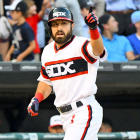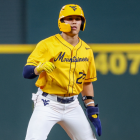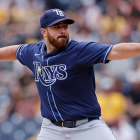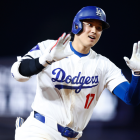NATIONAL HARBOR, Md. -- Major League Baseball's 30 front offices closed up shop on the winter meetings Thursday, ending a stretch of 96 straight hours holed up in dimly lit suites looking for the winning formula to come out ahead this offseason.
The thousands of discussions batted around during those four days will fuel a series of free-agent signings and trades over the next several weeks. In the meantime, let's break down the teams that fared best, and worst, at the meetings.
WINNERS
 Chicago White Sox
Chicago White Sox
Coming into this offseason, White Sox general manager Rick Hahn said he would trade any player on the roster with four years or fewer of controllable service time. That opened up a world of possibilities, and alerted 29 other teams that several stars could be had, if the price was right.
On Tuesday, Hahn traded the biggest of those stars. Moving lefty ace Chris Sale to the Red Sox netted MLB.com's No. 1 prospect in baseball, Yoan Moncada. Just 21 years old, Moncada has a swing and offensive potential that have been compared to Robinson Cano's. Rather than some rookie-league question mark, Moncada gives the White Sox a potential star player at an up-the-middle position who could become an everyday player in the big leagues as soon as next season.
Michael Kopech, 20, could become a second impact player going Chicago's way in the five-player deal. One of the hardest-throwing pitchers at any level, the triple-digit-pounding right-hander has a chance to become a front-line starter in the majors, if he can harness his erratic control (avoiding punching teammates with his pitching hand would help too).

The next day, Hahn expanded the scope of his shopping spree. In trading center fielder Adam Eaton to the Nationals, the White Sox GM said goodbye to a player with five years of controllable service time. The return on the trade more than justified the change of plan, though.
By zooming past his initial trade criteria, Hahn nabbed two premium pitching prospects, right-handers Lucas Giolito and Reynaldo Lopez. Ranked as MLB.com's No. 3 overall prospect coming into the 2016 season, Giolito's stock fell a bit due to a combination of slightly diminished fastball velocity, command issues and a rocky 21-inning cameo to start his major-league career. Lopez similarly struggled with walks last season, but profiles as an impact starter in his own right if he can pound the strike zone with more regularity.
(CBS Sports' Dayn Perry has more on the White Sox's quick, effective rebuild via these two trades, and you can read The Ringer's Michael Baumann on Giolito, Lopez and other impressive pitching prospects in a suddenly loaded White Sox system, which now includes six players from MLB.com's 2016 Top 100.)
More good news: By separating their top trade chits instead of packaging them together, the White Sox still boast several players who could fetch plenty in return for talent-hungry contenders. David Robertson, Todd Frazier, Jose Abreu and Melky Cabrera could all wear different uniforms on Opening Day 2017, with Robertson's value shooting up thanks to the exorbitant demands of free-agent closers Aroldis Chapman (more on him soon) and Kenley Jansen. With an impressive big-league résumé, a clean bill of health and multiple very cheap years of team control to offer, Jose Quintana could bring back a package of young talent not far off what Sale delivered.
If you're a White Sox fan dreaming of 2017 glory, the winter meetings were a disappointment. For those wishing for good tiding on the South Side in the years to follow, start getting psyched.
 Boston Red Sox
Boston Red Sox
We covered Boston's impressive haul earlier this week, with Sale and Tyler Thornburg significantly upgrading the rotation and bullpen.
Going from a monster final season by David Ortiz to light-hitting Mitch Moreland was a bit of a gut punch, though. That one-year, $5.5 million deal leaves the Red Sox an eyelash below next season's $195 million luxury-tax threshold.
(It was a bit surprising to see the players union approve a series of relatively tiny increases in that threshold over the next few seasons, given the downward push that would have on some salaries, at a time when every organization is swimming in television money, with smaller-market clubs getting additional boosts from revenue-sharing. It's far less surprising to see big-revenue team owners use that limit as an excuse to skimp on talent.)
With a lineup anchored by homegrown stars Mookie Betts, Xander Bogaerts, Jackie Bradley Jr. and Dustin Pedroia, a rotation that could see the defending Cy Young winner end up as the third-best starter on the roster next season, and an improved bullpen, nabbing Moreland off the bargain rack might not hurt too much, and the Red Sox still came out of this week in great shape. Given how low the asking price might be on multiple better available hitters, though, Sox fans still have a legitimate gripe.
 Chicago Cubs
Chicago Cubs
The 2016 Cubs rank as one of the most talented teams we've seen in the past decade, flush with excellent starting pitching, superior defense, multiple mashers in the lineup and plenty of young players with more upside. The only significant holes left to fill lay in the bullpen, where Aroldis Chapman's departure and Mike Montgomery currently being slated to take the fifth-starter job created a need.
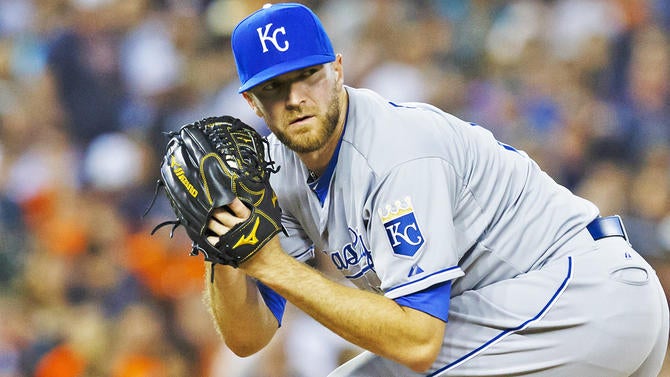
Consider that need addressed. By landing beastly closer Wade Davis from the Royals, the Cubs handled their most glaring roster deficiency without weakening the roster or giving up a blue-chip prospect. Free-swinging outfielder Jorge Soler could eventually blossom in K.C., but that was a long shot to happen quickly, and Cubs management recognized that a mini-dynasty could be in play, if the team could wipe out its weaknesses without giving up essential pieces.
Thursday's acquisition of right-hander Koji Uehara on a one-year, $4.5 million deal brought additional depth, with the veteran closer a good bet to ably handle setup work in Chicago, the occasional homers he's likely to give up hopefully offset by high strikeout rates and a bunch of weak contact.
If you're a trivia buff, the additions of Davis and Uehara stand out for both pitchers posting off-the-charts recent seasons, and for some impressive performances in World Series closeout games:
Random note: If Cubs finalize deal with Uehara, they'll have 3 pitchers on the roster who recorded final out of 3 of the last 4 World Series
— Sahadev Sharma (@sahadevsharma) December 8, 2016
LOSERS
 New York Yankees
New York Yankees
It's tough to understand what, exactly, the Yankees are trying to do. Yes, the Bombers overachieved in 2016 thanks in large part to a phenomenal performance by the back of their bullpen, and Aroldis Chapman played a big role in that success before getting sent to the Cubs in a deadline deal. But the five-year, $86 million deal the Yanks gave Chapman on Wednesday feels almost like a four-month unspoken covenant between player and team, without a thorough read of the market.
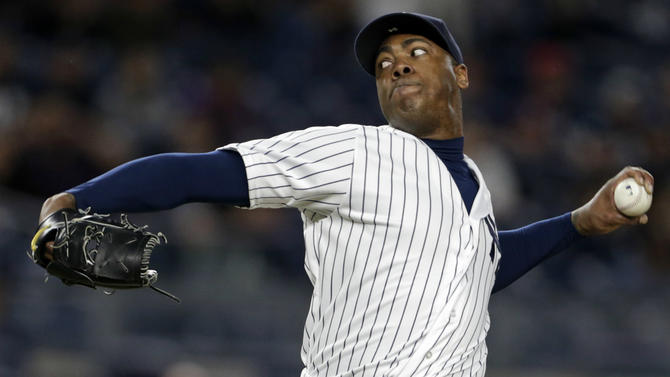
In Chapman, the Yankees acquire a missile-throwing lefty closer who is great right now, but remains subject to all of the attrition risks -- injuries, velocity declines and overall loss of effectiveness -- that usually hound relief pitchers over the long haul. Even at his best, Chapman has shown flashes of weakness, walking too many batters at times and turning into a one-pitch pitcher with men on base who got cuffed around multiple times in the playoffs when hitters sat on his 100 mph fastball on 2-0 and 3-1 counts.
If the Yankees truly had $86 million to burn, you would think they could have used that money to address multiple holes in their porous lineup, with Dexter Fowler and Justin Turner profiling as particularly good fits. If, on the other hand, the Yankees planned to play things conservatively and ride out the next two seasons playing respectable-but-not-great baseball before shooting the moon for Bryce Harper, Manny Machado and/or Josh Donaldson, it's tough to comprehend their confidence that Chapman will still be an impact reliever three, four and five years from now. Last winter's allegations of domestic violence, and the 30-game suspension that followed, make the biggest contract ever given to a relief pitcher all the more puzzling for a likely third- or fourth-place team.
 Miami Marlins
Miami Marlins
Kenley Jansen is an elite closer who doesn't come with the same character concerns that plague Chapman. Still, the right-handed fireballer carries a different kind of baggage with him as teams assess his worthiness as a free agent: draft-pick compensation. While Chapman's midseason trade to the Cubs wiped out the pick the Yankees would have otherwise had to surrender, any team that inks Jansen (other than the Dodgers, the team that made him a qualifying offer this offseason) will lose a first-rounder in the process.
This doesn't seem to bother the Marlins. Multiple reports have the Fish offering Jansen a five-year, $80 million contract, one that ignores the potential that a top-20 pick (Miami owns the No. 14 overall selection in the 2017 draft) provides. If the Marlins were willfully punting the future for an all-out run at a pennant this season, their hot-and-heavy chase for Jansen would make some sense. But it's hard to concoct a playoff scenario for this team.
The untimely death of staff ace Jose Fernandez in September created a gaping hole in the rotation (in addition to a wave of sorrow around the game), leaving an already weak starting five in even worse shape. A jarring lack of available starting-pitching talent on the free-agent market (inconsistent right-hander Ivan Nova is by far the best guy still out there) makes it tough to figure how the Marlins might get around that major flaw; handing a two-year deal to human pinata Edinson Volquez earlier this offseason was not the answer.
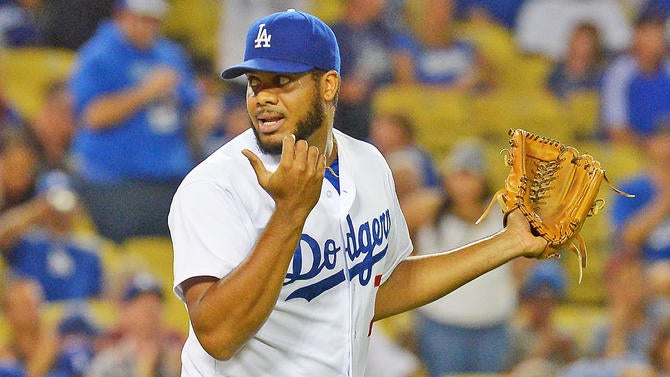
More broadly, the massive outlays for Chapman (and likely Jansen) ignore the terrible track record attached to long term for relief pitchers -- for every Andrew Miller, you get four or five B.J. Ryans. The best way to build a great bullpen is to stockpile as much young pitching talent as possible, figure out the best candidates to start, then slide everyone else into the pen. It's a strategy that has worked for multiple surprise contenders in recent years, most notably the 2014-15 Royals and the 2016 Indians (Miller got the headlines there, but closer Cody Allen was a homegrown arm, and the Indians nabbed several other key relievers cheaply from other teams before they blossomed in Cleveland).
Miami would be a better team with Jansen than without him. But it would still probably be a team with too many holes for a real playoff run, and a club with one less high draft pick that might be parlayed into the kind of pitching depth teams need for sustainable success.
You could argue that we shouldn't officially classify the Marlins as winter meetings losers until and unless they actually spend all that money (plus the first-round pick) on a closer. This is still, at the very least, a lousy strategy to even entertain, given all the variables involved.
BONUS WINNER: Claire Smith
The first female African-American newspaper reporter to ever cover baseball on a daily beat became the first woman to win the prestigious Spink Award. The Baseball Hall of Fame will honor Smith next summer in Cooperstown with the award, which recognizes "meritorious contributions to baseball writing."
This one is special for two reasons. First, Smith is a true pioneer and leader in her field, having distinguished herself through decades of excellence on the baseball beat while winning multiple other notable awards. Second, she is as kind and thoughtful a person as anyone in her industry.
In accepting the award at Tuesday's Baseball Writers Association of America meeting, Smith invited the six other female writers in the room to stand with her, then delivered an eloquent speech. She acknowledged "the guys that stood up to the athletes and teams and said that we are your peers and we deserve to be treated like you," then added, "I want to thank you as well as the women who walked the walk and fought the battles and got all of us to this point. No one does this by themselves.''
Smith and I worked together at ESPN, and few people have ever treated me with more kindness, in the baseball world or anywhere else. After the meeting, Smith accepted a long line of congratulations from fellow writers, following all of us giving her a standing ovation minutes earlier. When my turn in line arrived, she and I hugged. She cried, then I cried.
Smith's success, and this week's award announcement, remind us that great things can happen when the world opens doors for others, and that the old saw of nice guys finishing last is total bunk. You can be extraordinarily nice, and still be a leader in your field. And you sure as hell don't need to be a guy to make it happen.









